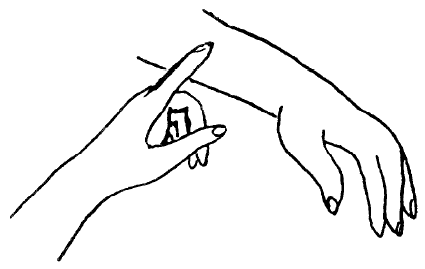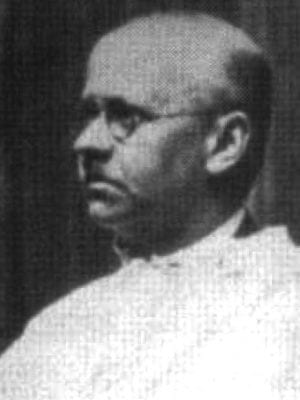Paul Hoffmann
Paul Hoffmann (1884-1962) was a German physiologist and physician.
Hoffmann has been referred to as the founder of modern German neurophysiology with honorary doctorates from the universities of Berlin and Zurich. He was said to have been esteemed as a person as well as a scientist because of his unpretentious discretion, his indefatigable assistance combined with critical and discerning judgement, his sense of humour, and his originality.
Known for describing Hoffmann-Tinel sign for assessment of nerve regeneration and success of nerve sutures (1915).
Biography
- Born 1 July 1884 in Dorpat, Russia
- 1905-1909 Studied medicine at the Universities of Leipzig, Marburg, and Berlin
- 1909-1911 Assistant at the Institute for Physiology of the University of Berlin.
- 1909 – Medical degree University of Berlin
- 1911 – Assistant to Max von Frey (1852 – 1932) at the physiology institute of Würzburg University; investigating action potentials of muscles and the electrophysiology of reflexes
- 1914-1918 Worked in field hospitals in France and a military hospital in Würzburg. Hoffmann found that in wounded soldiers, percutaneous percussion of injured and regenerating peripheral nerves elicits a tingling phenomenon which radiates into the sensory distribution of that nerve.
- 1917 – Associate Professor, Policlinic of Internal Medicine at Würzburg
- 1920 – First to describe the H (Hoffmann) reflex resulting from electrical stimulation of peripheral nerves
- 1924 – Director of the Institute for Physiology at the University of Freiburg-im-Breisgau, where he worked until his retirement, despite the institute building being completely destroyed by an air strike in November 1944.
- 1961 – Honorary doctorates from the universities of Berlin and Zurich
- Died 9 March 1962
Medical Eponyms
Hoffmann-Tinel sign (Tinel sign) (1915)
In March and August 1915, Hoffmann published two papers in Medizinische Klinik describing a method to assess both the success of nerve sutures, and the possible spontaneous recovery of nerve injuries. Hoffmann described a sign performed by lightly percussing with an extended finger in a localized area over the proximal nerve stump or by percussing distally to proximally along the segment of nerve injury or repair.
Es ist keineswegs starker Druck notwendig, um die Empfindung hervorzurufen, am allerbesten erreicht man es durch Klopfen mit dem gestreckten Finger (wie man es bei der Perkussion nicht machen soll). Die falsche Lokalisation wird von den Patienten mit vollkommener Sicherheit angezeigt, es gehört dazu offenbar nur eine sehr geringe Aufmerksamkeit, eine viel geringere, als sie bei der Hautsinnprüfung notwendig ist.
Hoffmann 1915: 360
It is interesting to note that it is not necessary to use more than the lightest pressure to achieve stimulation of these newly regenerated fibres, and the effect is actually best when stimulation is applied by light percussion with the finger in extension (the opposite of the technique otherwise used for percussion). The area of misplaced sensation is indicated by the patient with such absolute certainty, that only minimal attention is necessary for its detection, in fact much less than would be necessary in normal sensory testing of the skin.
Hoffmann 1915: 360

Die meisten Patienten bezeichnen die Empfindung als Stechen. Es handelt sich offenbar um heftige Parästhesien, wie jeder Gesunde sie beim Wiedererwachen eines „eingeschlafenen“ Glieds empfindet. Die Lokalisation, und das ist wichtig, ist offenbar sehr leicht. Es wird von den Patienten mit voller Bestimmtheit angegeben, wohin sie die Empfindung verlegen.
Hoffmann 1915: 857
Most patients describe the sensation as pins and needles. This obviously indicates an intense paraesthesia, similar to the normal sensation experienced when an extremity “goes to sleep.” It is an important point that localization of the sensation is apparently quite easy. The patients are able to indicate with complete certainty the area in which the sensation is experienced.
Hoffmann 1915: 857
Major Publications
- Hoffmann P. Über eine Methode, den Erfolg einer Nervennaht zu beurteilen. [Using a method to assess the success of a nerve attack] Medizinische Klinik, 1915; 11: 359-360
- Hoffmann P. Weiteres über das Verhalten frisch regenerierter Nerven und über eine Methode, den Erfolg einer Nervennaht frühzeitig zu beurteilen. [Additional findings regarding nerve regeneration and the method of early evaluation of the success of nerve repair]. Medizinische Klinik. 1915; 11: 856-858.
Controversies
“Hoffmann-Tinel-sign‘ may be a misnomer.
- March 1915 – Paul Hoffmann observed the progress of nerve regeneration by tapping over the carpal tunnel. Hoffman described his test in relation to a single soldier with radial nerve (nervus musculospiralis) injury.
- October 1915 – Jules Tinel, observed the progress of nerve regeneration after gunshot wounds by pressing over the carpal tunnel. Tinel described “Le signe du Fourmillement” in numerous injured nerves
Note: The Hoffmann sign, or Hoffmann reflex relates to Johann Hoffmann (1857-1919)
References
- Jung R. Paul Hoffmann 1884-1962. Ergeb Physiol. 1969;61:1-17.
- Hoffmann P, Buck-Gramcko D, Lubahn JD. The Hoffmann-Tinel sign. 1915. J Hand Surg Br. 1993; 18(6): 800-5
- Koehler PJ, Bruyn GW, Pearce JMS. The Hoffmann-Tinel Sign. Neurological Eponyms. 2000: 136-143
- Sansone JM, Gatzke AM, Aslinia F, Rolak LA, Yale SH. Jules Tinel (1879–1952) and Paul Hoffmann (1884–1962). Clin Med Res. 2006; 4(1): 85–89.
- Turgut AÇ, Tubbs RS, Turgut M. Paul Hoffmann (1884-1962 AD) and Jules Tinel (1879-1952 AD), and their legacy to neuroscience: the Hoffmann-Tinel sign. Childs Nerv Syst. 2019; 35(5): 733-734.
- Bibliography. Hoffmann, Paul. WorldCat Identities

